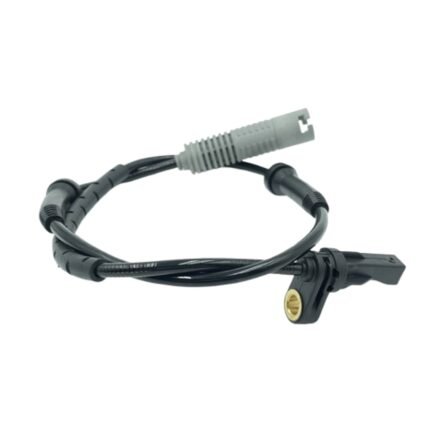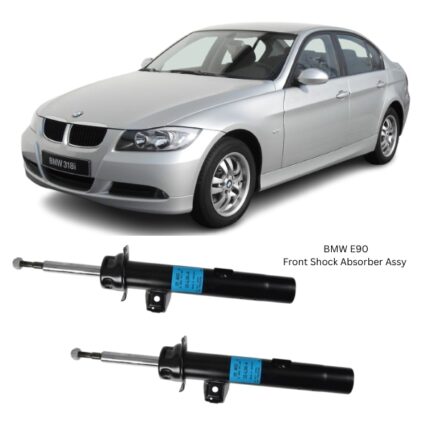Get BMW E90 Front Shock Absorber Assy 31316782329 in Kenya
The Front Shock Absorber Assembly is a crucial component of a vehicle’s suspension system, designed to manage and control the motion of the front wheels. It plays a pivotal role in maintaining vehicle stability, ride comfort, and tire contact with the road surface. Properly functioning front shock absorbers contribute significantly to safe handling, predictable braking, and overall vehicle control under varying driving conditions.
Shock absorbers work in conjunction with coil springs and other suspension elements to absorb and dampen road irregularities, reduce body movement, and prevent excessive bounce. The front shock absorber assembly is specifically engineered to endure constant dynamic loads and high-impact forces, especially given that the front suspension system bears the majority of the vehicle’s weight during braking and steering.
Purpose and Function
The primary purpose of the front shock absorber assembly is to:
-
Control Spring and Suspension Movement:
It prevents the vehicle from bouncing excessively after hitting a bump by converting kinetic energy into heat energy via hydraulic damping. -
Ensure Tire Contact with the Road:
By minimizing wheel hop and vibration, it keeps tires planted firmly on the road surface, which is critical for steering and braking performance. -
Enhance Ride Comfort:
It smooths out the ride by reducing the impact of potholes, speed bumps, and uneven terrain. -
Stabilize the Vehicle Body:
It controls body roll, pitch, and dive during cornering, acceleration, and braking, helping maintain balance and passenger comfort.
Without properly functioning shock absorbers, the suspension system cannot operate effectively, leading to compromised safety and performance.
Construction and Key Components
A Front Shock Absorber Assembly typically includes a combination of hydraulic and structural components housed in a durable, corrosion-resistant shell. It is engineered to endure continuous, rapid up-and-down motion in harsh operating environments.
Common Components:
-
Shock Absorber Tube (Damper Body):
The main outer casing that holds hydraulic fluid and internal components. Often made of steel or aluminum and treated for corrosion resistance. -
Piston and Rod:
The piston moves through fluid inside the tube, generating damping force. The rod connects the piston to the vehicle’s chassis and is typically chrome-plated to minimize wear and friction. -
Hydraulic Fluid:
Specially formulated oil provides resistance as the piston moves, enabling the shock to absorb energy and control motion. -
Valves and Orifices:
Precisely engineered to meter fluid flow and provide consistent damping performance under various loads and speeds. -
Dust Boot / Bump Stop:
Protects the piston rod from road debris and contaminants while preventing damage from full compression. -
Mounting Points / Bushings:
Allows secure attachment to the vehicle’s frame and suspension arms. High-quality bushings reduce noise and vibration transmission. -
Spring Seat (in strut-type assemblies):
Some front shock absorbers integrate a spring perch to support the coil spring, forming a complete strut assembly.
Types of Front Shock Absorber Assemblies
Depending on the suspension design, a front shock absorber assembly may come in different forms:
-
Twin-Tube Design:
Features an inner cylinder for damping and an outer chamber for fluid overflow. Offers a balance of performance and cost-efficiency. -
Mono-Tube Design:
A single, large cylinder containing both piston and gas charge. Known for faster response and superior heat dissipation, commonly used in performance applications. -
Gas-Charged Shocks:
Filled with nitrogen gas to reduce aeration (foaming) of the hydraulic fluid, improving consistency and fade resistance. -
Strut Assemblies:
Combine the shock absorber with a coil spring and mounting hardware into a single integrated unit, offering both damping and structural support.
Performance and Handling Benefits
Replacing a worn or damaged front shock absorber assembly with a high-quality unit offers multiple benefits:
-
Improved Steering Precision:
Maintains front wheel alignment and helps ensure accurate steering response. -
Shorter Braking Distance:
With tires maintaining firm road contact, stopping performance becomes more consistent and efficient. -
Enhanced Cornering Stability:
Reduces body roll and improves balance during turns. -
Better Ride Comfort:
Absorbs vibrations and impacts from road imperfections, resulting in a smoother driving experience. -
Reduced Tire and Suspension Wear:
Minimizes oscillations and bounce that lead to uneven tire wear and premature fatigue in suspension components.
Signs of a Worn Front Shock Absorber Assembly
Over time, shock absorbers wear out due to constant movement and exposure to extreme conditions. Common signs that the front shock absorber assembly needs replacement include:
-
Nose Diving When Braking:
Excessive forward pitch during deceleration indicates weakened damping control. -
Excessive Bouncing:
A bouncy ride over bumps or speed humps suggests the shock is no longer absorbing motion effectively. -
Steering Instability:
Wandering or vague steering response, especially on rough roads, points to poor damping. -
Uneven Tire Wear:
“Cupping” or scalloped tire wear patterns result from uncontrolled wheel movement. -
Fluid Leaks:
Visible oil leakage from the shock body indicates internal seal failure. -
Clunking or Rattling Noises:
Worn bushings or loose mounting points can cause audible knocking over bumps.
Replacing worn shocks promptly is essential for vehicle safety and ride quality.
Installation and Replacement Guidelines
Replacing a Front Shock Absorber Assembly is a moderately technical task that should be done using the proper tools and safety procedures.
General Steps:
-
Lift and Secure the Vehicle:
Use a jack and jack stands or a lift to gain safe access to the front suspension. -
Remove the Front Wheel:
Provides clear access to the shock absorber assembly. -
Disconnect Mounting Bolts:
Loosen and remove the bolts or nuts at both the top and bottom of the shock. Strut assemblies may also require removal of sway bar links or brake line brackets. -
Remove the Old Shock Assembly:
Carefully lower and remove the assembly from its position. -
Install the New Shock Absorber Assembly:
Position and secure the replacement unit, ensuring torque specifications are followed. -
Reassemble and Test:
Reinstall all removed components, test for proper alignment and road test the vehicle to verify improvement.
In the case of strut-type shocks, a spring compressor may be needed to safely transfer the coil spring.
Maintenance Tips
To maximize the life and performance of the front shock absorber assembly:
-
Inspect Regularly:
Check for leaks, noise, or physical damage during routine maintenance. -
Replace in Pairs:
Always replace both front shocks together to ensure balanced handling and damping. -
Avoid Overloading:
Consistent overloading can shorten the shock’s lifespan and compromise performance. -
Monitor Tire Wear:
Uneven patterns may indicate underlying suspension issues. -
Follow Manufacturer Guidelines:
Adhere to the service intervals and use recommended components for your specific system.
Follow us on Facebook for more parts.




